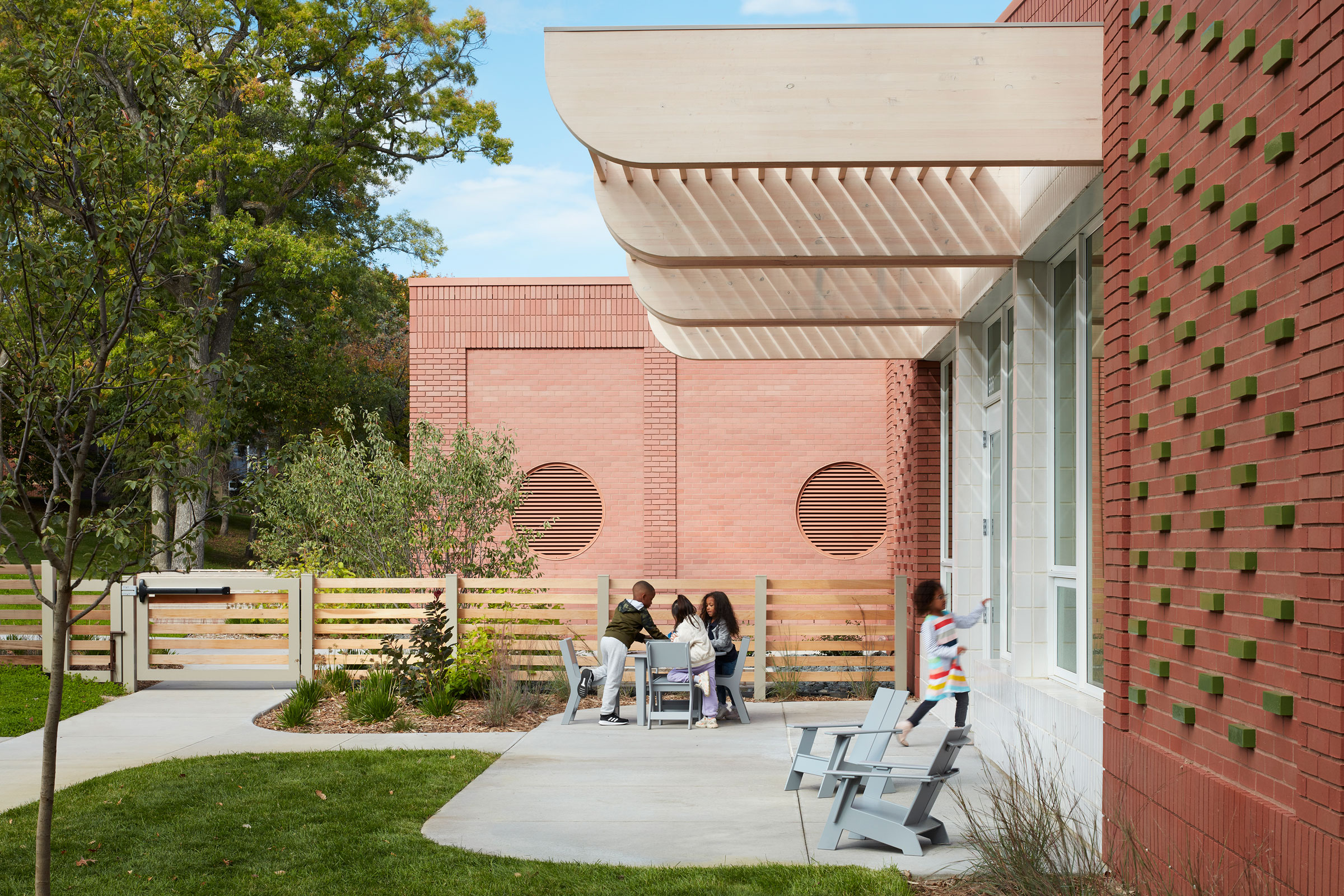Story at a glance:
- Healthy, energy-efficient, and environmentally friendly learning institutions have a positive impact on students, teachers, and the world at large.
- Sustainable school design can reduce carbon emissions, lower operating costs, and provide healthier indoor environments, higher attendance rates, and improved productivity.
- Daylighting, green building materials, and flexible design are just a few of the strategies used in sustainable school design.
K-12 schools spend approximately $8 billion annually on energy and emit an estimated 72 million metric tons of carbon dioxide, or the equivalent of 18 coal-fired power plants per year, according to the DOE. How can school design reduce its carbon footprint?
Let’s consider the nature of sustainable school design. In this article we explore the benefits associated with green schools, investigate the most popular strategies and trends in eco-friendly school design, and explore 15 real-world examples of sustainable school architecture.
What is Sustainable School Design?

Annie E. Fales Elementary School is a sustainable school in Massachusetts that boasts net-positive carbon status, producing more power via renewable energy than it requires in a year’s time. Photo by Ed Wonsek
Sustainable school design may be described as a subset of the broader sustainable architecture movement—one that seeks to construct healthy, efficient, and ecologically friendly learning facilities whose operations have a positive impact on both people and the planet as a whole.
The USGBC’s Center for Green Schools defines a sustainable or green school as one that reduces environmental impacts and costs, improves occupants’ health and performance, and provides effective sustainability education. In practice sustainably designed schools achieve these goals by drastically limiting energy and water use, reducing waste production, protecting nearby natural habitats, minimizing exposure to VOCs and other toxins, maximizing natural light, and more.
Benefits of Sustainable School Design
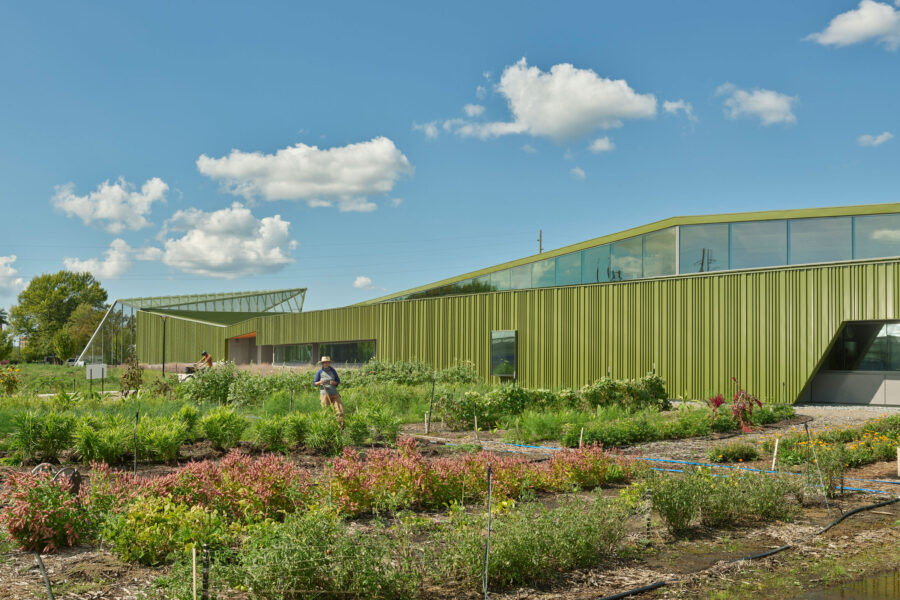
A lush landscape adjoins Thaden School’s Home Building, with Marlon Blackwell Architects’ Reels building in the background. Photo by Tim Hursley
While the initial benefits of sustainable school design—e.g. improved energy efficiency and fewer emissions—may seem obvious, there are a plethora of lesser-known benefits that come with designing sustainable academic facilities.
Reduced Environmental Impact
The main benefit of sustainable school design is that it helps to reduce the environmental impact of the buildings we learn and teach in—something that is undeniably necessary if we hope to stop or slow climate change.
Schools that implement sustainable design strategies tend to operate much more efficiently than conventional schools and, as a result, generate far fewer greenhouse gas emissions. Many schools also take steps to reduce their water usage, helping to conserve water and effectively mitigate excess stormwater runoff.
The Thaden School, for example, is one such learning institution that has taken steps to reduce its environmental impact across the board. A geothermal field works to minimize electric heating and cooling loads while low-maintenance native landscaping dominates the grounds, helping to restore natural habitats and improving biodiversity; the campus also grows a large portion of its produce and composts all organic kitchen waste.
Higher Attendance & Teacher Retention Rates
According to the CDC, students ranging between the ages of 5 and 17 miss an estimated 14 million school days each year due to asthma, and teachers have a much higher risk of developing asthmatic conditions than almost any other non-industrial worker group. This is often attributed to the fact that schools are among the worst offenders when it comes to effectively maintaining indoor humidity levels within the optimal range (30 to 50%), which in turn increases the amount of exposure to allergens, irritants, germs, and other airborne pollutants.
Schools that have been designed with sustainability in mind typically do a better job at maintaining that optimal humidity level and often make use of highly-efficient ventilation strategies that filter out or exhaust the bulk of pollutants before they are inhaled. This translates to higher attendance rates and reduces the risk of large-scale virus transmission amongst students.
Another benefit of sustainable school design is the effect it has on teacher retention rates. A report on the impact of green schools in Washington state found that implementing sustainable design strategies reduced teacher turnover rates by approximately 5%.
Lower Operating Costs
Schools that implement sustainable design strategies focused on reducing energy consumption—such as daylighting, natural ventilation, geothermal heating, higher levels of insulation, et cetera—predictably have lower operating costs than those designed to conventional building standards.
A 2006 report called “Greening America’s Schools: Costs and Benefits” found that green schools used 33% less energy and 32% less water than schools which did not feature sustainable features. Similarly, a more recent study of schools in Toronto found that LEED-certified schools had 28% lower operating costs compared to both conventional schools and even those that had undergone deep energy retrofits.
Improved Productivity & Test Scores
Because schools that implement sustainable design strategies typically feature ample daylighting and improved indoor air quality—both of which are known to positively affect cognition—they also tend to have higher productivity rates and test scores.
A year-long study conducted by the Heschong Mahone Group in 1999, for example, collected data on the amount of daylight available in more than 2,000 classrooms across three school districts in California, Washington, and Colorado. In the California district the study found that students in extremely sunny classrooms advanced 26% faster in reading and 20% faster in math than students in daylight-deprived classrooms. In the Washington and Colorado districts ample exposure to natural light increased test scores between 7 and 18%.
Healthier Indoor Environments
Sustainably designed schools place a high priority on using green building materials, daylighting systems, solar-shading solutions, and high-efficiency ventilation systems. Altogether these strategies help ensure schools provide adequate air circulation, maintain stable humidity levels, and minimize the entry of dirt, dust, pollen, mold spores, or other small particulate matter that might otherwise cause or trigger respiratory illnesses and afflictions.
Sustainable School Design Principles & Trends
Sustainable school design trends tend to align with the overarching principles associated with sustainable architecture as a whole. Some of the most popular include:
Daylighting
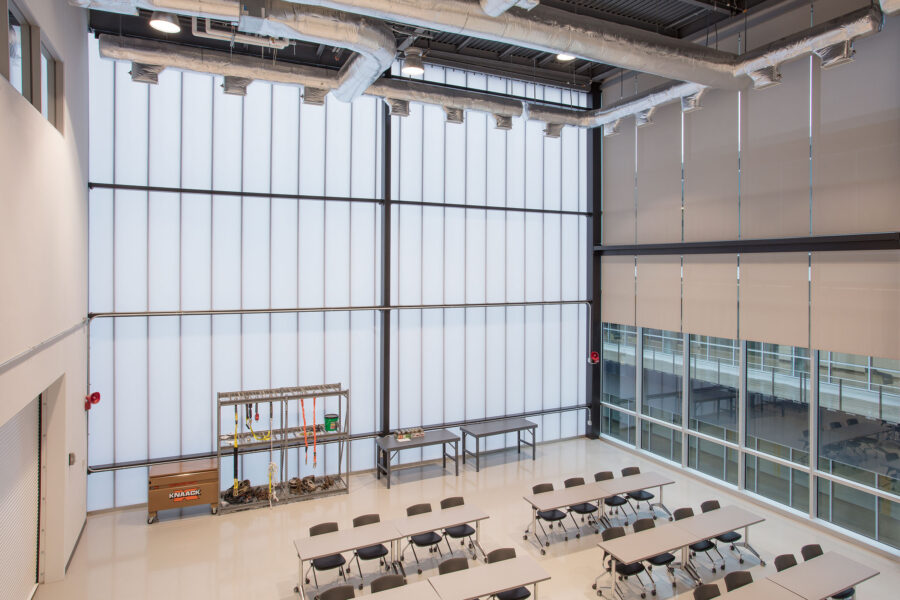
The Kingspan UniQuad product allows for large monolithic building skins to be fully translucent with carefully balanced interior daylight illumination, like at Collin College Technical Center. Photo courtesy of Kingspan Light + Air
Perhaps the most prolific and popular trend in sustainable school design, daylighting—or the intentional use of light-admitting devices to illuminate an interior space via natural sunlight—is more than just a means of saving energy. It also improves student mental health and well-being.
Receiving adequate sunlight throughout the day is crucial to maintaining the body’s circadian rhythm—or the internal clock that helps control and regulate various bodily functions and systems.
“By exposing your body to daylight throughout the day, your healthy human circadian rhythm will have a significant role in regulating your sleep-wake cycle and have a positive impact on your eating habits and digestion, body temperature, hormone release, and other important bodily functions,” Neall Digert, vice president of innovation and market development at Kingspan Light + Air, wrote in a previous gb&dPRO article.
Students who learn in sunny classrooms have been observed to be more attentive, are capable of concentrating better and for longer periods of time, and generally learn more efficiently than students in artificially lit classrooms.
Energy-Efficient Windows
Many schools have large windows throughout their campuses to let in as much light as possible, but the most sustainable schools install windows that aren’t just large, but energy-efficient. This helps prevent a significant amount of energy waste, as the DOE estimates anywhere from 25% to 30% of a building’s heating and cooling energy is lost through its windows. There are two main characteristics that improve a window’s energy efficiency: increasing the number of panes and the use of a low-emissivity coating or film.
Increasing the number of panes in a window helps improve its overall insulative quality, with most energy-efficient windows containing two or three panes of glass. An inert gas such as argon or krypton fills the space between each pane, reducing the amount of heat transferred through the glass itself. To protect against UV rays and prevent unwanted solar heat gain, a low-emissivity coating is then applied to the glass, reflecting solar energy without compromising natural daylight admittance.
Energy-efficient windows also help to improve concentration in the classroom, as double- and triple-paned windows provide better outside noise reduction than traditional single-pane windows.
Skylights & Light Tubes
Skylights and light tubes are two other daylighting solutions often employed in school buildings that allow for greater admittance of sunlight throughout the day. The Flora Arca Mata Elementary School in Stockton, California, for example, made extensive use of Solatube’s SolaMaster Series 750 DS tubular daylighting systems in order to work around design constraints that would not have allowed the placement of large windows found in most schools.
These light tubes collect sunlight from the rooftop and funnel it through highly reflective tubes into the classrooms below, providing consistent illumination throughout the day. In this manner, students are still able to receive the positive cognitive and psychological benefits of sunlight without requiring the installation of large windows. Solatube also provided Daylight Dimmers for each system installed, giving teachers the ability to easily adjust classroom daylight levels.
Solar Shading
A key component of passive solar design, solar shading refers to those features used to optimize the amount of solar heat that enters a building. Effective solar shading devices serve to block solar heat gain during the hottest months of the year (to prevent overheating) while still allowing sunlight to enter during the coldest months in order to exploit its thermal properties.
The Wintringham Primary Academy in St. Neots, England is prime example of effective solar shading in action. The dRMM–designed academy uses passive solar shading and a wider overhang on the school’s south-facing side than its north side. This feature helps block excess solar heat gain from the high-angled summer sun while still allowing solar energy to enter during the winter for passive heating.
Improved Ventilation
Technologies to improve ventilation, air circulation, and indoor air quality are often overlooked in sustainable school design.
Natural Ventilation
Mechanical HVAC systems can help circulate air throughout a building, but they don’t always do a great job of expelling pollutants, and they often create stale indoor environments. Natural ventilation systems, on the other hand, pull in fresh air, circulate said air, and then remove that air in a continuous cycle driven by the volumetric pressure differences caused by either wind or buoyancy.
Studies have shown that breathing in fresh air helps improve oxygen flow to the brain, which in turn promotes enhanced cognitive function, memory retention, and concentration—all of which are conducive to a productive learning environment.
Besides having a positive impact on mental health, natural ventilation also helps reduce operational energy costs. It is for these reasons that the sustainable, nature-inspired Child Care Center in Paraguay employs sliding glass walls to facilitate passive ventilation on fair-weather days.
Heat & Energy Recovery Technology
Natural ventilation isn’t always possible—especially for schools located in dense urban areas with higher concentrations of outdoor air pollutants. But that doesn’t mean there aren’t other ways to sustainably improve ventilation and indoor air quality. High-efficiency HVAC systems, for example, may be outfitted with either heat or energy recovery capabilities.
Heat recovery ventilation (HRV) and energy recovery ventilation (ERV) systems are incredibly efficient and are typically capable of recovering at least 75% of the heat from incoming or outgoing air. A ventilation system with balanced heat recovery ensures that a building always receives plentiful, nearly room temperature fresh air year-round, making for a much more comfortable indoor environment and drastically improving indoor air quality.
Use of Nontoxic & Low-VOC Materials
Sustainable school design also places a high priority on using non-toxic, low-VOC materials and products in place of mass-produced, non-renewable building materials. These materials tend to have lower embodied carbon, create fewer GHG emissions during their procurement, processing, and manufacturing, and do not leach as many harmful chemicals or compounds into the air over time.
To ensure the environment is as healthy and student-friendly as possible, many sustainably designed schools take care to prioritize materials and products bearing the Red List–free label. The International Living Future Institute’s Red List is a comprehensive guide to the “worst in class” chemicals, materials, and elements known to cause serious harm to human and ecosystem health. Red List–free products fully disclose 100% of their ingredients at or above 100ppm in the final product and do not contain any chemicals on the Red List.
Sustainable, child-safe materials—including vinyl flooring, stainless steel paint, EO grade environmental protection boards, water-based paint boards, and more—were, for example, specified by VMDPE when designing the IBOBI Super School in China to provide students with healthy spaces to learn and play.
Offsite Prefabrication
Offsite prefabrication, or the preconstruction of certain building components that are then transported to—and assembled at—the job site, is another growing trend in sustainable school design. The highly-controlled environment in which prefabricated materials are manufactured ensures a high level of quality and accuracy, making for tighter building envelopes and increased energy efficiency.
Entire rooms or modules can be prefabricated off-site, but the most common occurrence of prefabrication technology in sustainable school design is the use of precast concrete panels and slabs. The Henderson-Hopkins School in Baltimore, for example, uses grooved precast concrete exterior cladding to mimic the “form-stone” commonly found throughout the city’s architecture.
Renewable Energy Integration

King Open/Cambridge Street Upper Schools & Community Complex utilize both solar and geothermal power to supply energy for heating, cooling, and ventilation. Photo courtesy of William Rawn Associates
Integrating renewable energy sources into educational facilities is a growing trend, especially when it comes to solar power. This is largely because many schools are constructed in open areas that receive little-to-no shade throughout the day—conditions that are ideal for the installation of rooftop solar panels or photovoltaic arrays.
Geothermal heating and cooling is another form of renewable energy that is slowly becoming more and more commonplace within the field of sustainable school design, as evidenced by the King Open/Cambridge Street Upper Schools in Chicago, which utilize a total of 190 closed-loop geothermal wells to supply radiant heating, cooling, and displaced ventilation to their classrooms. Kate Bubriski, director of sustainability and building performance at Arrowstreet—the firm that designed the school—told gb&d that they chose geothermal because “ground source heat pumps were the most efficient systems and have reliable maintenance and durability.”
Integrating renewable energies is also more-or-less a requirement for schools seeking to achieve Net Zero Emissions status and can help a school earn credits for LEED certification.
Flexible & Adaptable Floor Plans
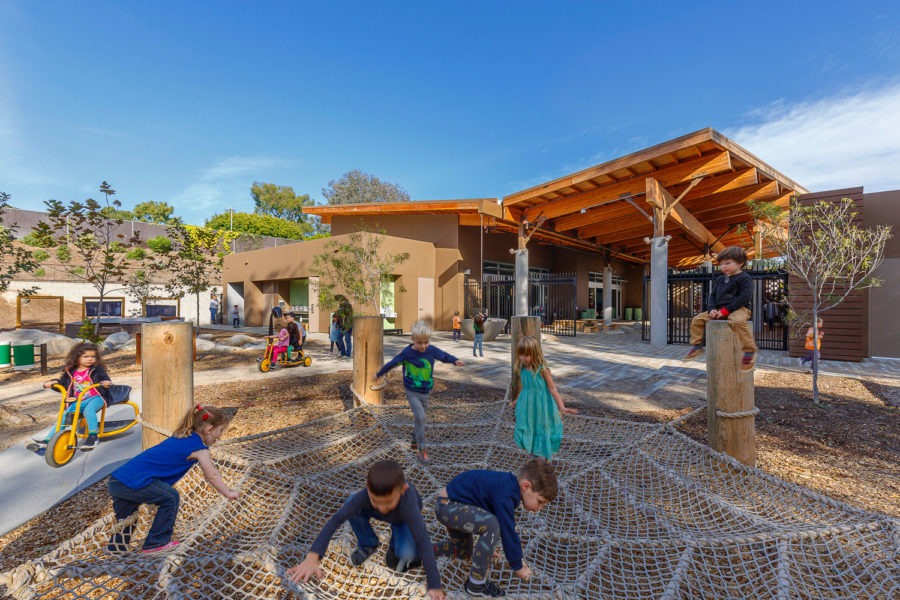
The ENC Nature Preschool was designed by LPA for maximum flexibility, with large classrooms and movable furniture. Large sliding glass doors allow for classes to extend to the outdoors when needed, effectively doubling the room sizes. Photo by Cris Costea Photography
In anticipation of future growth and reconfiguration, many modern schools are designed with flexible, adaptable floor plans that allow for classrooms and communal spaces to be changed around without requiring a complete renovation. By designing for flexibility from the outset, schools are able to extend their lifespan and reduce the amount of construction waste generated over the building’s operational life cycle.
Canyon View High School in Arizona is one school that has taken measures to maximize classroom flexibility. Designed by the DLR Group, Canyon View is laid out as a series of customizable learning suites that can stand alone or be connected or and resized to suit a variety of settings. “These are highly flexible learning suites that have a variety of environments in them, so they’re not your not typical ‘cells and bells,’” Todd Ferking, principal at DLR Group, previously told gb&d. Flexible, dynamic learning spaces like these help to engage students and provide them with a real sense of place.
Flexible design is also exemplified by the ENC Nature Preschool in Newport Beach, whose classrooms are easily reconfigured and feature movable walls that allow indoor spaces to open up to the outdoors at a moments notice.
15 Examples of Sustainable School Design
Here are a few inspiring examples of sustainable school design from around the world.
1. Blake School Early Learning Center, Hopkins, MN
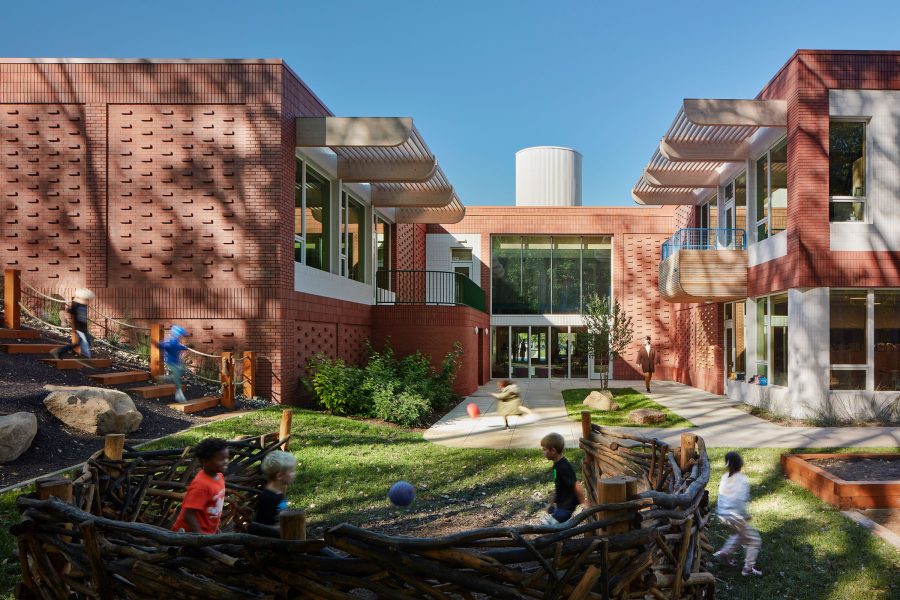
The Blake School ELC building frames its main entrance, forming an indoor-outdoor town square. Photo by Kendall McCaugherty
Designed by HGA for the Blake School—a private, non-sectarian college preparatory day school—the Early Learning Center (ELC) follows the Reggio Emilia teaching philosophy by creating community-building opportunities and encouraging students to learn through hands-on exploration and observation.
The new building is located down the hill from the school’s original building and employs a split-level design, rising out of the hillside as a collection of boxes resembling a set of children’s building blocks. An indoor/outdoor plaza anchors the space, providing opportunities for activity, interaction, and connection—a common theme throughout the building’s design, as evidenced by the liberal use of open, communal spaces like the overlapping cafeteria/library.
To help lower the project’s embodied and operational carbon, mass timber was used extensively throughout the building in the form of exposed glulam columns, glulam beams, and cross-laminated timber decking. Leaving the timber columns and beams exposed allowed HGA to eliminate carbon emissions—approximately 500,000 kilograms, to be precise—associated with wraps and wallboards commonly used to hide steel-framed structures.
Keeping natural materials like wood visible is also beneficial from a biophilic design perspective, as it helps create a warm, welcoming environment. “The decision to go with wood and expose it was about doing a lower-carbon structure,” Nat Madson, design principal at HGA, told gb&d in a previous publication. “But the client and user groups were excited about the idea of the structure being expressed and exposed. You can see how the building is assembled, and it was a real driving idea.”
Beyond material choices, biophilia serves as a core component of the center’s design and layout—each classroom offers direct access to the outdoors while large windows and light monitors provide ample daylighting opportunities. Canopies formed by glulam beams extending beyond the building’s facade dapple the natural light streaming into the classrooms, creating a forest-like environment that blurs the line between inside and outside.
A geothermal field situated underneath the center’s parking lot—combined with a variable refrigerant flow system—helps reduce the building’s energy-related costs and emissions while ensuring a high degree of occupant comfort. The ELC also practices sustainable landscaping and stormwater management, making extensive use of basins planted with hardy, native grasses to help slow and retain runoff.
Completed in 2023, the Blake School Early Learning Center is Minnesota’s first fossil fuel-free, non-collegiate educational building and is currently pursuing LEED Gold certification.
2. Annie E. Fales Elementary School, Westborough, MA

The Annie E. Fales Elementary School in Massachusetts uses solar and geothermal power to produce more energy than it uses annually. Photo by Ed Wonsek
As the first net-positive energy public school in New England, the Annie E. Fales Elementary School blends sustainable and educational design to foster a sense of environmental and social responsibility in young students from an early age.
Designed by HMFH Architects, the Annie E. Fales Elementary School earned net-positive status by employing a rooftop photovoltaic solar grid and 40 geothermal wells to generate its power. HFMH chose to install a sawtooth roof in order to maximize surface area for the school’s south-facing PV panels and increase their efficiency. These renewable energy systems allow Fales to produce 11.6% more energy than it needs.
Fales’ interior learning areas are organized into four project areas, each of which are centered around different landscapes found in Massachusetts: forest, meadow, marshland, and pond. Each area corresponds to a specific grade level and boasts a unique, biome-specific color palette as well as storybook-style murals.
“The murals help get the students excited about where they live, wanting to get out and explore as well,” Caitlin Osepchuk, project architect and associate at HMFH Architects, told gb&d in a previous article. “And foster that love of the environment so they’ll continue to make positive sustainable choices in the future to help maintain the ecosystems they live in.”
3. Thaden School, Bentonville, AR
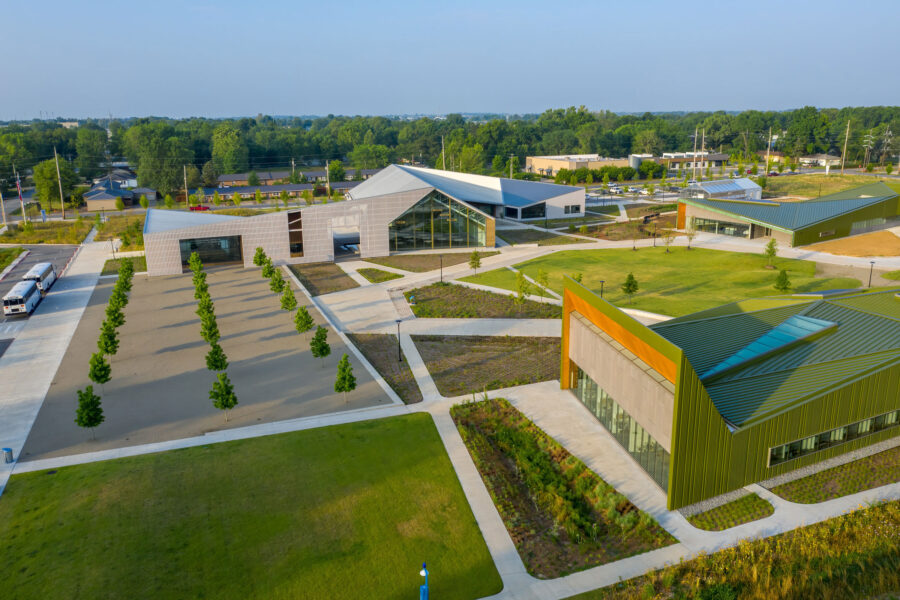
Thaden School sits on a 26-acre site in Arkansas. Here the Home Building is seen in the rear of campus. Photo by Tim Hursley
Owned and operated by the Walton Family Foundation, the Thaden School is an independent middle and high school in Arkansas that stands out thanks to its extensive implementation of green building strategies and unique curriculum. The campus includes seven buildings and was designed by EskewDumezRipple in collaboration with Marlon Blackwell Architects.
The Home Building is one of the school’s most impressive structures, with a state-of-the-art teaching kitchen and dining hall. It’s a hub for “learning by doing,” a principle that defines the school’s approach to education. At the building’s rear an ever-present water-lab collects a large portion of onsite rainwater and serves as a teaching opportunity for showcasing certain biological processes.
The adjacent landscape is also an expertly crafted learning opportunity. Designed for minimal maintenance while encouraging biodiverse plant life, the grounds around the Home Building are home to native ecosystems as well as orchards, planter boxes, and fruit and vegetable fields. These crops are harvested by students and then cooked and prepared in the dining hall for student meals. All organic waste is returned to the soil as compost fertilizer, creating one giant closed-loop system.
In the quad field next to the Home Building a geothermal well field acts as a giant battery and further helps to reduce overall energy costs. “The Home Building was designed to achieve an EUI of 23 or less. The baseline EUI for a typical high school building as defined by ASHRAE is 74 kBTU/sf*yr,” Christian Rodriguez, principal at EskewDumezRipple, wrote in a previous gb&d article. “This means the Home Building was designed to be approximately 70% more efficient than similar schools.”
Schools with an EUI of 25 or less are commonly considered to be zero energy ready—and with plans to add a rooftop photovoltaic solar array in the future, the Home Building is well on its way to achieving net-zero status.
4. P.S. 19X, New York City
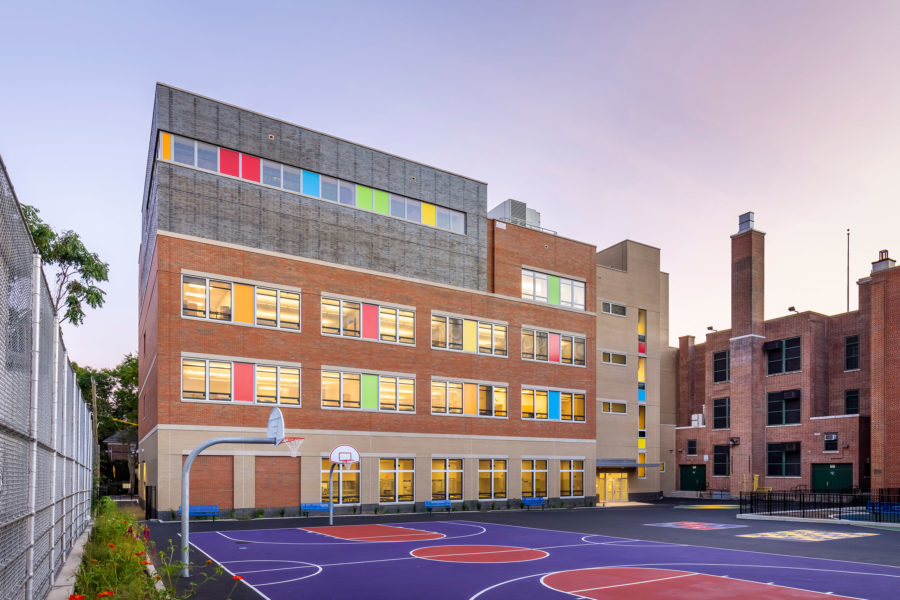
Colorful window surrounds on the exterior exude a playful atmosphere at P.S. 19X, also known as The Judith K. Weiss Woodlawn School in the Bronx. Photo by Albert Vecerka
Designed by RKTB to LEED Gold standards, P.S. 19X is an addition to the existing Judith K. Woodlawn School that significantly improved the entire campus’ sustainability. The extension created capacity for 200 more students and added new administrative buildings, a double-height gymnasium, combined cafeteria and auditorium, and a new street-level entrance with an inviting, and an open lobby complete with elevators to ensure accessibility.
One of the things that RKTB prioritized when designing R.S. 19X was improving the school’s energy efficiency. “The backbone of sustainable construction is energy efficiency, and we employed systems and materials that help to reduce overall energy costs by more than 30% compared to the Green Schools Guide baseline,” Nelya Sachakova, an associate at RKTB, wrote in a previous gb&d article. “To relieve pressure on the HVAC system, we used R-15 insulation in the above-grade wall assemblies and R-10 in those below grade; roof construction included R-30 insulation under a performative cool roof that helps reduce heat gain.”
An incredibly airtight building envelope, daylight harvesters, lighting occupancy sensors, and a state-of-the-art building management system help to further reduce the school’s energy consumption. P.S. 19X also sources over 35% of its electricity from renewable energy sources, though it does not feature any on-site renewables itself.
P.S. 19X is also incredibly efficient when it comes to water usage. Low-flow fixtures and high-efficiency plumbing reduced the school’s water requirements by more than 30% above the Green Schools Guide baseline. Outdoor spaces were landscaped using a native bunchgrass that requires minimal maintenance and no permanent irrigation, effectively reducing the school’s landscaping water requirements to near zero.
RKTB also renovated the existing building, replacing all of the outdated administrative and assembly spaces with modern classrooms featuring ample daylighting and operable windows, as well as updated technology, materials, finishes, and systems.
5. Wintringham Primary Academy, St. Neots, England
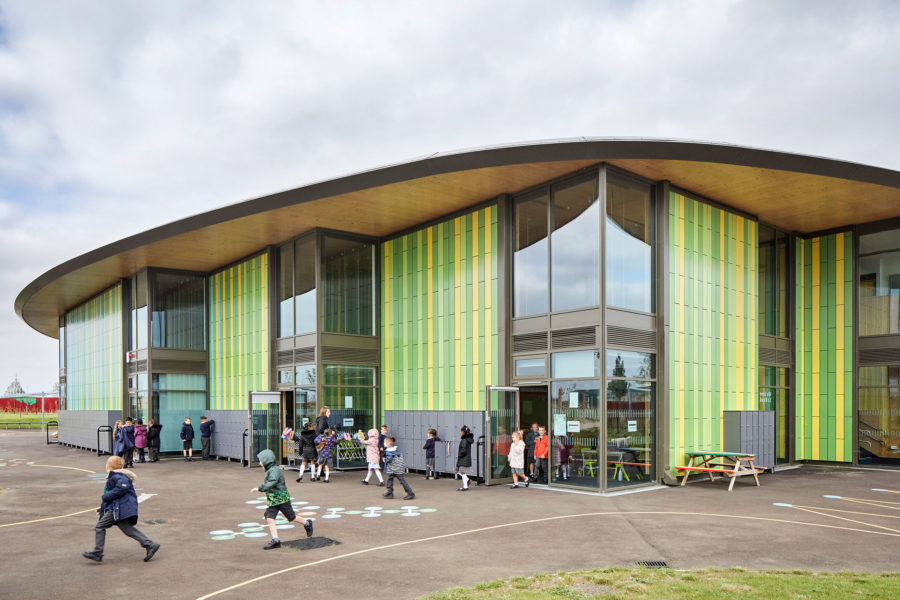
A cross-laminated timber school building, designed by dRMM Architects, allows students to learn and play indoors and out. Photo by Hufton+Crow Photography
The dRMM-designed Wintringham Primary Academy is organized as two stacked floors of classrooms surrounding an inner landscaped courtyard, known as the grove—a layout that quite literally puts nature at the heart of the school’s design. “It’s quite radical and progressive, but it’s also looking back to 19th century models of schools,” Philip Marsh, a founding director at dRMM, previously told gb&d.
At roughly 32,464 square feet, the unique configuration of Wintringham Primary Academy allows natural sunlight to flood the entire building while also making natural cross-ventilation possible, greatly reducing the need for artificial lighting and mechanical ventilation. An energy-efficient building envelope and strategic solar shading features also help reduce the school’s heating and cooling loads.
To reduce the school’s overall environmental impact even further, Wintringham Primary Academy was constructed primarily from cross-laminated timber (CLT), a type of structural engineered wood product with a load-bearing capacity similar to that of concrete or steel, but much lighter and significantly more sustainable. The school’s use of CLT effectively sequesters 166 metric tons of carbon, giving it just 49% of the carbon impact of a conventional school.
Much of the CLT was intentionally left exposed by the design team, in part to reduce the need for additional building materials but also to provide a natural warmth and reinforce the school’s connection to the natural world. A flexible, easily re-configured floor plan was implemented throughout the building to allow the school to adapt and evolve to future needs without necessitating a complete renovation.
Landscaped green spaces—including play areas, sports fields, and even nature trails—are positioned around the school, along with four acres of wildflower meadows and amenity grassland. Native grasses, perennials, shrubs, and trees were planted in order to attract a variety of crucial bird and insect species as well as reintroduce biodiversity to the area.
6. IBOBI Super School, Shenzhen, China
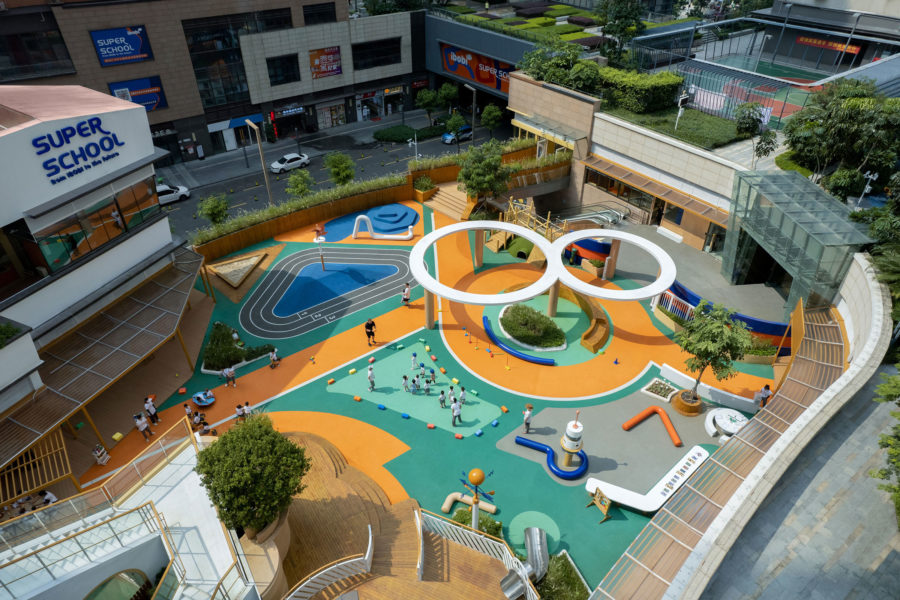
IBOBI Super School is located on the terrace of the second floor of a mall—one of few places in the area with large outdoor space. The outdoor terrace and the indoor space are well connected, forming an enclosed site. Photo by ZC Studio
Designed by VMDPE, the IBOBI Super School is a comprehensive kindergarten that provides a safe, healthy, and sustainable space for children to learn and play in a dense city with little green space.
On the second floor of a mall, the IBOBI Super School’s most impressive feature is its large outdoor terrace area, designed to be as flexible as possible and accommodate a range of activities. “Our key design elements are the redefinition of outdoor functionality, creating not only spaces for sports but also social interaction areas, hand-craft activities, outdoor STEAM courses, and greenhouse functionalities,” Vinci Chen, VMDPE’s team design director, previously told gb&d.
Large windows and a series of porches blur the division between indoor and outdoor spaces, allowing students and educators to enter and exit adjoining spaces freely regardless of weather conditions. Sustainable, child-safe materials—including vinyl flooring, stainless steel paint, EO grade environmental protection boards, water-based paint boards, and more—were used to construct both the interior and outdoor spaces.
Building constraints and IBOBI’s elevated location limited the amount of vegetation it could reasonably support, although the VMDPE design team did its best to incorporate greenery where possible, selecting a variety of Chinese silver grass as the main species.
7. Canyon View High School, Waddell, AZ
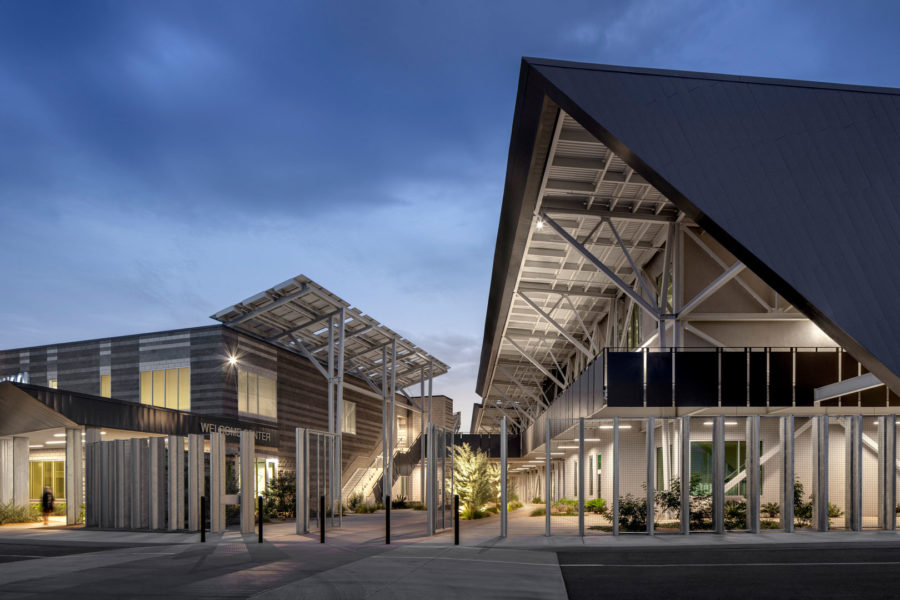
The exterior of Canyon View High School in Arizona, designed by DLR Group. Photo by Bill Timmerman
DLR Group designed Canyon View High School with a series of indoor and outdoor teaching spaces. These sustainable spaces include student dining, a learning stair, an athletic training corridor, outdoor project rooms, a maker space, broadcasting studio, theaters, and more.
All of the school’s interior spaces are daylit and glare-free, with large windows and skylights to reduce the need for artificial lighting. A geothermal ground-source heat pump supplies the school’s radiant floors with heat. Canyon View High School generates up to 20% of its own power using a 250 KW solar array.
One of the buildings on-campus also uses a BioPCM® ENRG Blanket® from Phase Change Solutions, which may be tuned to enable active heat absorption in the summer and release stored heat in the winter, reducing heating and cooling loads throughout the year. The school operates 75% more efficiently than a traditional high school located within the same climate.
8. Great Lakes Academy Charter School, Chicago
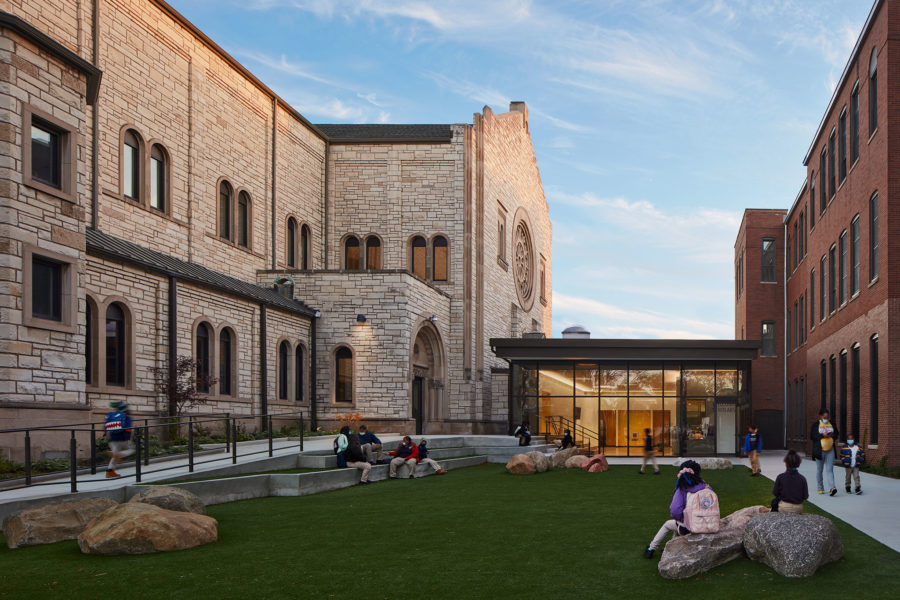
Wheeler Kearns Architects linked and repurposed former Archdiocese of Chicago buildings for a charter school campus. Photo by Kendall McCaugherty, Hall + Merrick Photographers
Originally a campus owned and operated by the Archdiocese of Chicago, the Great Lakes Academy (GLA) Charter School is an inspiring example of adaptive reuse.
The Wheeler Kearns Architects–designed school occupies almost an entire city block in South Chicago, but that wasn’t always the case. When it first opened in 2014 GLA was simply a three-story brick building circa 1911, with two floors of classrooms and a cafeteria / gymnasium. Anticipating future expansion, Wheeler Kearns initially intended to construct a 30,000-square-foot building across the street, but GLA decided it made greater financial sense to acquire the entire campus and renovate the existing church, originally built in 1952.
“The former church building’s size, layout, and orientation were remarkably well-suited for the school’s program,” Emily Ray, a project architect with Wheeler Kearns Architects, previously wrote for gb&d. “A regulation middle school basketball court fits perfectly in the transept, and half of the student body can comfortably fit in the nave during each of two lunch periods. The team transformed the raised altar into a multipurpose performance stage and unique transverse climbing wall.”
A 4,000-square-foot lobby connects the two buildings and represents the only new construction on the site. Two other buildings—both in poor condition—were demolished to make room for a new turf field that helps divert stormwater and reduce groundwater runoff.
Repurposing these existing buildings was just the first step in improving the campus’ overall sustainability. To reduce the school’s energy consumption, the design team utilized variable refrigerant flow units and energy recovery technology to efficiently heat, cool, and ventilate the building, while thermally broken curtain-wall framing, skylights, and large windows drastically limit the need for artificial lighting. A native planted green roof was also installed to provide passive cooling, mitigate runoff, and reintroduce biodiversity to the site.
9. The Child Care Center, Villeta, Paraguay
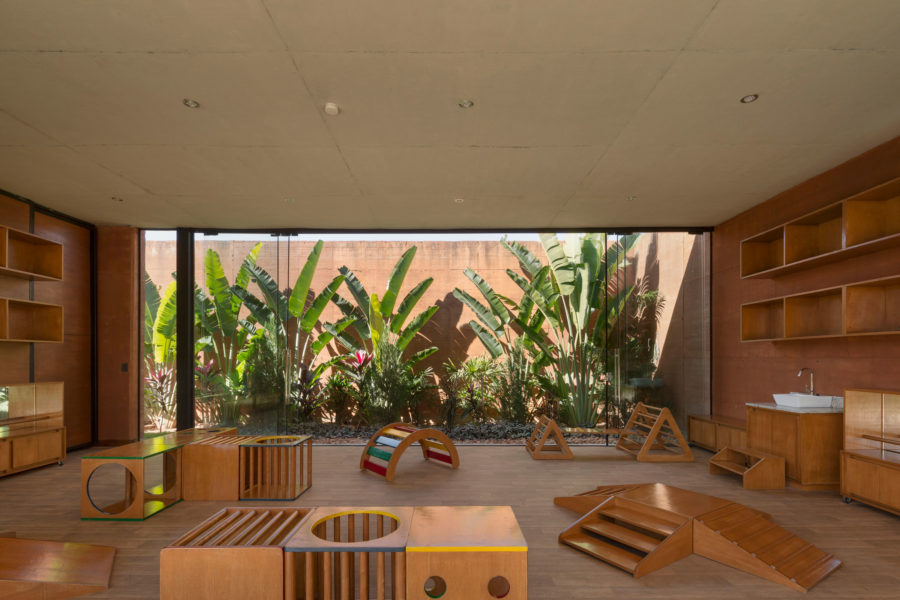
Classroom walls open to green courtyard spaces. “We intended to make the experience of the place feel very comfortable and connected to nature,” says Horacio Cherniavsky of Equipo de Arquitectura. Photo by Federico Cairoli
Serving as both school and daycare, this center in Paraguay aims to encourage independent sensory learning and connect children with the natural world from a young age via biophilic design elements.
“We wanted children to be in contact with nature and natural materials at all times,” Horacio Cherniavsky, a founding member of Equipo de Arquitectura, told gb&d in a previous article. “We did not want to create the typical classroom where you feel you are inside a closed space.”
Designed by Equipo de Arquitectura the Child Care Center encompasses two classrooms, a dining room, and an administrative area, each of which is open to the outdoors on two sides. This design allows sunlight and fresh air to move through the classrooms, greatly reducing the need for mechanical heating and cooling, ventilation, and artificial lighting. During inclement weather, sliding glass walls may be drawn across these openings, offering protection without obscuring views of the surrounding landscape.
The walls are made primarily from rammed earth and are incredibly resilient—grounding the building within the environment while creating diverse colors, textures, and even smells that enrich the occupant experience. “It’s a sensory type of learning,” Cherniavsky says. “The experience of the space is what helps the child learn from his or her senses.”
Indoor plants, courtyard gardens, and green rooftops further reinforce the center’s commitment toward sensory learning, with the latter also helping to mitigate stormwater runoff and passively regulate interior temperatures.
10. Federal Way High School, Federal Way, WA
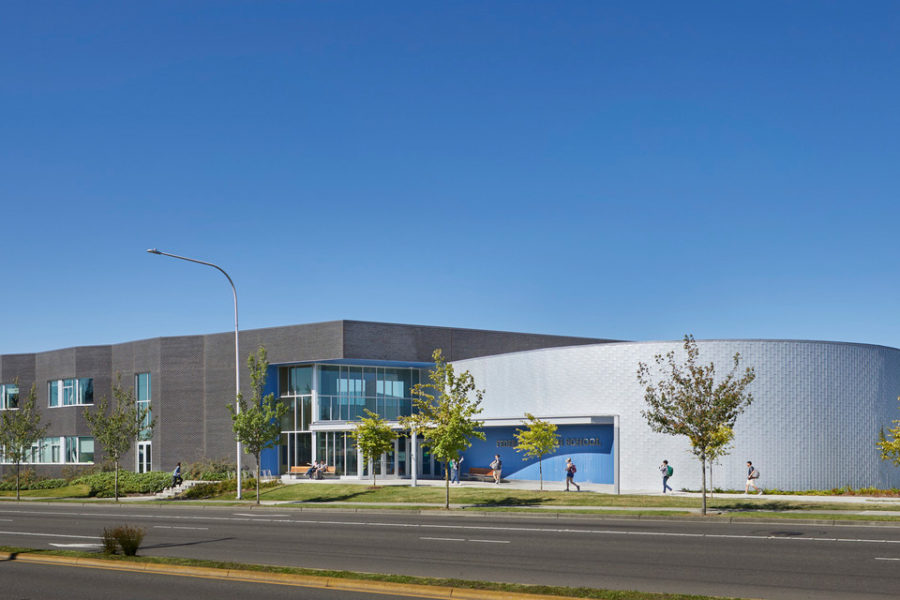
Federal Way High School, Washington. Photo by Benjamin Benschneider
The SRG Partnership-designed Federal Way High School is an inspiring example of sustainable school design that prioritizes the wants and needs of the students themselves while also balancing the concerns of the township at large.
To ensure the new school met the community’s needs and honored the site’s legacy as the location of Federal Way’s first school system, SRG Partnership conducted a range of forums to give people from all backgrounds voice in the design process.
“The vision for Federal Way High School was to honor the school’s heritage while celebrating its present and creating opportunities for growth into the future,” Ingrid Krueger, senior associate at SRG Partnership, previously wrote for gb&d. “The greatest hope for the school is that what exists now will inspire new generations of teachers, staff, and students to create their own stories, a renewed history, and a new place of pride in their community.”
Federal Way High School is separated into two halves—one half houses the auditorium, activity rooms, and gymnasiums while the other is almost entirely dedicated to classroom space. Connecting the two halves is a network of communal spaces that allow students to connect with one another or find solitude without being wholly isolated from their peers.
Ample daylighting solutions flood the school with natural sunlight and strategically located structural elements ensure that the classrooms and communal spaces may be reconfigured in the future if necessary. Ballfields, walking paths, and a storm pond habitat serve to further connect the school to the community, opening it up to the public rather than isolating it behind physical barriers.
11. The ENC Nature Preschool, Newport Beach, CA
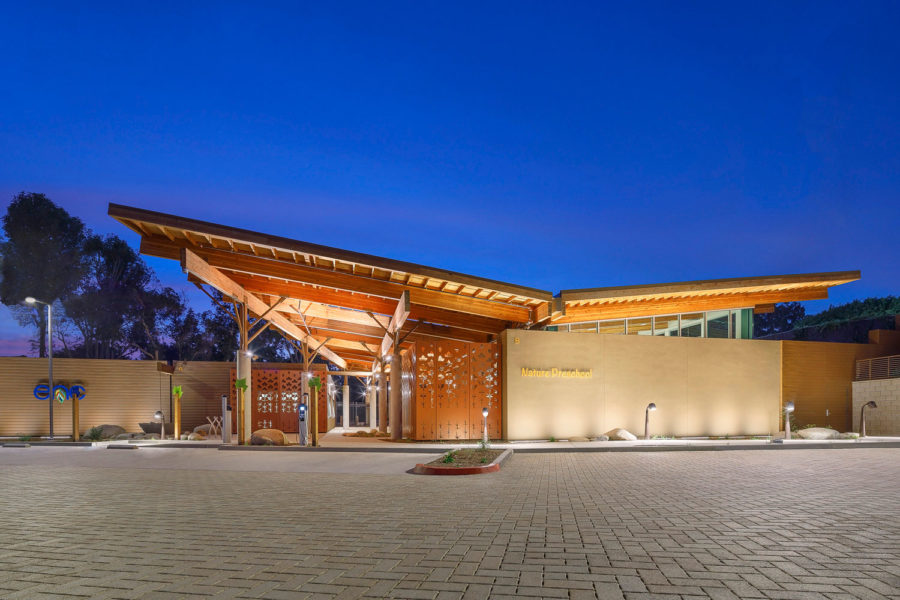
The ENC Nature Preschool, designed by LPA Design Studios, was the region’s first LEED Platinum building. Photo courtesy of LPA
LPA Design Studios designed the ENC Nature Preschool (ENC) in Newport Beach as the first LEED Platinum building in the region. The ENC Nature Preschool is also a net-positive building—generating 60% more energy than it uses. The ENC’s 8,000-square-foot, three-classroom preschool also operates at a net-positive, with renewable energy producing 105% of the school’s power. This is achieved through the use of a well-integrated array of photovoltaic solar panels and innovative energy-reduction strategies.
Passive design techniques like natural ventilation and optimized building orientation—angled to take full advantage of ocean breezes—help regulate interior temperatures without excessive reliance on mechanical HVAC use, whereas the facility’s large windows and butterfly roof allow for ample daylighting that reduces the need for artificial lighting.
“We researched historical climate data, which made it clear the site was ideally suited for a naturally ventilated building,” Rick D’Amato, design director at LPA, previously told gb&d. “We were able to eliminate the need for mechanical ventilation with operable windows, large sliding glass doors, and efficient ceiling fans to enhance air movement.”
The pitch of the school’s butterfly roof also serves to direct rainwater into a series of rock basins and bioswales for effective stormwater mitigation.
12. Montgomery Middle School, Chula Vista, CA
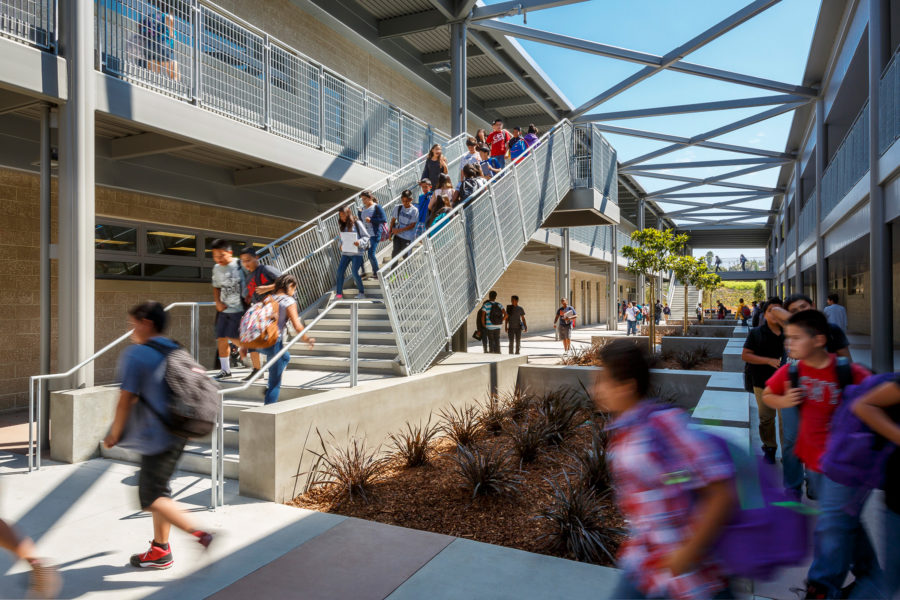
Montgomery Middle School. Photo courtesy of LPA Design Studio
Originally built in the 1970s, the Montgomery Middle School in Chula Vista underwent an extensive expansion in 2015 to address existing water damage and accommodate a growing population. LPA designed this 37,500-square-foot addition to LEED Platinum and net zero energy standards, with a 217-kW photovoltaic system on the roof.
To reduce energy consumption LPA oriented the school on an east-west axis, reducing the amount of harsh exposure from the south, which in turn reduces solar heat gain and the need for mechanical air conditioning. Each classroom has its own high-efficiency HVAC unit linked to the campus’ energy management system.
Montgomery Middle School also features an innovative stormwater management system. Because of the school’s geographic location runoff quickly ends up in the ocean, meaning a stormwater treatment system was a must. LPA’s solution was to include a bioswale—or a channel that naturally slows and filters water before redirecting it elsewhere.
Other sustainable features include natural landscaping with drought-tolerant plants, light-colored surfaces to combat the urban heat island effect, energy-efficient lighting systems, light shelves that reflect light deeper into the building, and low-flow bathroom fixtures to conserve water.
13. Henderson-Hopkins School, Baltimore
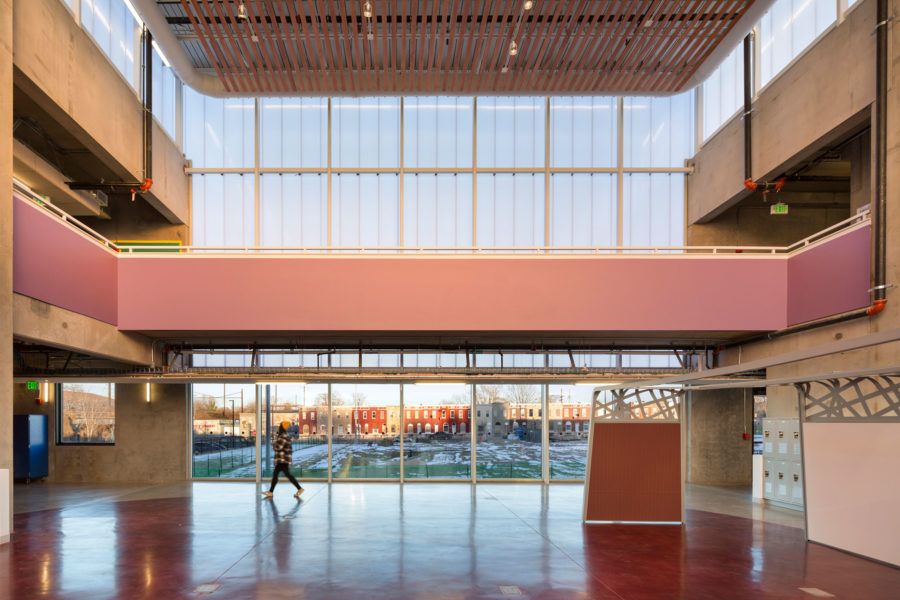
Designed by ROGERS PARTNERS Architects+Urban Designers, The Henderson-Hopkins School opened in Baltimore in 2014. Photo courtesy of Albert Vecerka/Esto
The Henderson-Hopkins School in Baltimore is a safe, healthy, and sustainable development project designed to bring both educational facilities and community services under the same roof. The school is part of revitalization efforts spearheaded by East Baltimore Development and was one of the first projects in the Baltimore City Green Building Standards Program when it was completed in 2014.
The school accommodates children from 6 weeks old through 8th grade and serves as a family resource center that provides everything from health access to housing services. An auditorium, gym, and library are also housed on campus and are open to the public throughout the day.
ROGERS PARTNERS designed the campus as a microcosm of the city itself, with the school broken up into small-scale buildings—bisected by main streets and side streets—designed to serve two grades at a time. Each building features a flexible floor plan and includes an exterior classroom for students to learn in. “Having space that is set up from day one as an exterior learning space—I think that’s something we’re going to see more of,” Vincent Lee, an associate at ROGERS PARTNERS Architects+Urban Designers, previously told gb&d.
Almost 100% of the campus’ occupied spaces receive ample natural lighting, with 275 windows, 40 skylights, and a translucent daylighting system helping the school meet LEED daylighting requirements, drastically reducing the need for artificial lighting. Insulated precast concrete panels were used to construct each building’s envelope, greatly improving energy efficiency and reducing mechanical HVAC loads.
14. King Open/Cambridge Street Upper Schools & Community Complex, Cambridge, MA

Arrowstreet and William Rawn Associates chose geothermal heating to work alongside photovoltaics to power the King Open/Cambridge Street Upper Schools & Community Complex. Photo courtesy of William Rawn Associates
Encompassing King Open Elementary and Cambridge Street Upper School, administrative offices, a library, and even a public pool, the King Open/Cambridge Street Upper Schools & Community Complex in Cambridge, Massachusetts is the state’s first Net Zero Emissions and LEED Platinum-certified school campus
Arrowstreet and William Rawn Associates designed the King Open/Cambridge Street Upper Schools & Community Complex to achieve net zero status by leveraging geothermal and solar energy. The building uses 43% less energy than a typical school in Massachusetts and 70% less energy than the average school in the United States.
The campus features 190 closed-loop, 500-foot-deep geothermal wells that supply radiant heating and cooling to each building, as well as the air handling units supporting the project’s displacement ventilation system. A grid of approximately 36,000 facade and roof-mounted photovoltaic panels generate a large portion of the school’s electricity.
“The technologies needed to design the building to net zero, including geothermal wells and photovoltaics, were less than a 1% increase in construction cost,” Kate Bubriski, director of sustainability and building performance at Arrowstreet, told gb&d in a previous article. “The significant operational savings from the low energy building and onsite photovoltaics make the return on capital investment fairly immediate.”
King Open/Cambridge Street Upper Schools & Community Complex also isn’t lacking when it comes to water conservation. Rain gardens, bioswales, and an innovative water reuse system help the project effectively mitigate stormwater runoff while also reducing total on-site water use requirements.
15. Mark Day School, San Rafael, CA
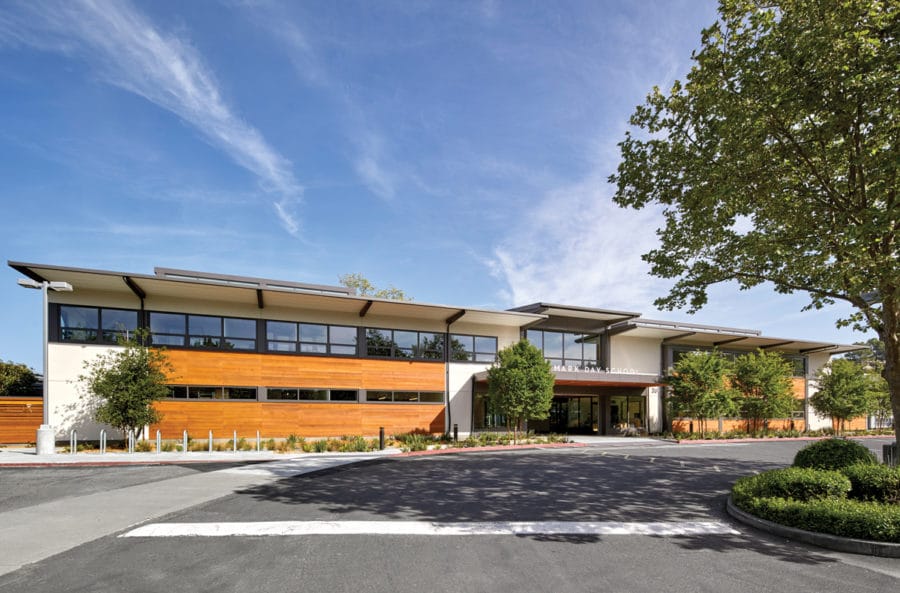
The Mark Day School’s new Learning Commons, Creativity Lab, and Administration Building achieved LEED Platinum certification. Photo courtesy of EHDD
Originally built in the 1960s, the Mark Day School undertook a capital campaign in 2015 and 2016 to fund the demolition and reconstruction of the existing Administration Building, commissioning local architectural firm EHDD for the project.
EHDD started by demolishing the existing single-story structure and constructing a two-story building in its place, one that housed not only Administrative offices but also a new Learning Commons (library) and Creativity Lab. The school’s existing central outdoor quad also received improvements, including the reorienting of the amphitheater and addition of new seating areas to foster a greater sense of community during weekly all-school meetings.
Like many modern educational facilities, the new building was designed with flexibility in mind—all of the tables are movable, walls slide, and the entire building itself is clear span, giving school administration the ability to reconfigure the space in the future if necessary.
EHDD emphasized daylighting solutions, solar shading strategies, high-quality insulation, and a highly efficient heat pump as part of its sustainable design strategy. A rooftop solar array supplies the Mark Day School with almost twice the amount of electricity the new building uses on an annual basis.
Stormwater is also collected from the roof and funneled through visible infrastructure into rain gardens in the courtyard, while bioswales help disperse ground-level runoff and encourage biodiverse habitat growth. All in all, these improvements helped the new building earn LEED Platinum.

